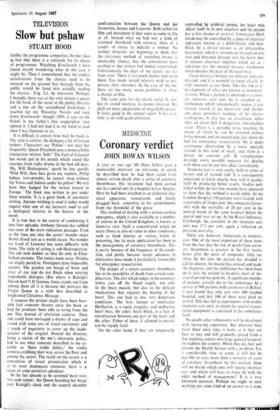Coronary verdict
MEDICINE . JOHN ROWAN WILSON
A year or two ago Mr Peter Sellers gave a memorable interview on television, in which he described how he had been saved from almost certain death after a series of coronary thromboses. His treatment had been carried out in a special unit in a hospital in Los Angeles. Here he had been attached to an elaborate elec- trical apparatus, resuscitated, and finally dragged back, somewhat to his astonishment, from the threshold of the grave.
This method of dealing with a serious cardiac emergency, which is also available at a number of centres in the United Kingdom, is known as intensive care. Such a concentrated attack on acute illness is also of value in other conditions, such as head injuries or various forms of poisoning, but its main application has been in the management of coronary thrombosis. This is partly because of the frequency of the condi- tion, and partly because recent advances in electronics have made it particularly favourable for emergency resuscitation.
The danger of a severe coronary thrombosis lies in the possibility of death from certain com- plications. The clot which lodges in the coronary artery cuts off the blood supply, not only fo the heart muscle, but also to the delicate mechanisms that regulate the beating of the heart. This can lead to two very dangerous conditions. The first, known as ventricular fibrillation, is a rapid, irregular, and ineffective heart beat; the other, heart block, is a lack of coordination between one part of the heart and the other. Either of these, if allowed to persist, can be rapidly fatal.
On the other hand, if they are temporarily controlled by artificial means, the heart may adjust itself to its new situation and the patient has a fair chance of survival. Ventricular fibril- lation may be controlled by a piece of electrical apparatus known as a defibrillator, and hear block by a device known as an intracardiat. pacemaker, which is introduced through an arir vein and threaded through into the heart; hert it initiates electrical impulses which act as t. substitute for the normal nervous rnechanisn • which decides the pace of the heart beat.
These electrical devices are delicate and cow plicated, and it is essential to know exactly th
right moment to use them. This has led to tt. development of what are known as monitorin systems. When a patient is admitted to a coro: ary intensive care unit, he is attached to mechanism which automatically makes a con tinuous record of his heart-rate and rhythm and gives periodical readings of his electro cardiogram. It also has an attachment -whicr rings an alarm bell if dangerous abnormalities occur. There is a portable x-ray machine; by means of which he can be screened without being moved, and an oxygen pipe just above the bed for emergency resuscitation. He is under continuous observation by a nurse specially trained in this kind of work, and there is a doctor on constant call. If complications develop, every possible measure for dealing with them can be put into effect immediately.
Intensive care is very costly, both in terms of money and of trained staff. It is consequently important to know exactly how well it justifies itself by producing better results. Studies pub- lished within the last few months have appeared to show that the method is worth while. At the London Hospital 150 patients were treated, with a mortality of 14 per cent; this compares favour- ably with the mortality of 28 per cent in the general wards of the same hospital before the special unit was set up. At the Royal Infirmary Edinburgh, the mortality in the intensive care unit was 17.5 per cent, again a reduction on previous mortality.
There are, however, limitations to intensive care. One of the most important of these stems from the fact that the risk of death from coron- ary thrombosis is greatest in the first twelve hours after the onset of symptoms. Only toe often, by the time the patient has decided to call his doctor, the doctor has arrived and made the diagnosis, and the ambulance has been fixed up to take the patient to hospital, most of this crucial period has gone by. A significant number of patients actually die in the ambulance. In a survey of 900 patients with coronaries in Belfast. it was found that only just over 400 reached hospital, and that 100 of these were dead on arrival. This has led to experiments with mobile intensive care units in which the special resusci- tation equipment is contained in the ambulance itself.
No doubt other refinements will be developed with increasing experience. But whatever final form these units take, it looks as if they are here to stay and will gradually spread from a few teaching centres into large general hospitals throughout the country. When they do, they will present the Health Service with a problem. For a considerable time to come, it will not be. possible to treat more than a minority of cases' of coronary thrombosis by this method. How will we decide which ones will receive intensive' care and which w ill have to make do with the older method of management? It is a very awkward question. Perhaps we ought to start. working out some kind of an answer to it now.;






























 Previous page
Previous page